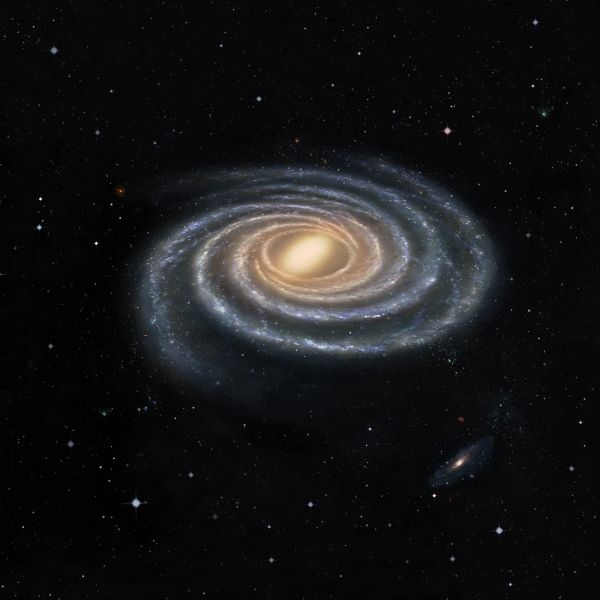It is self-righteous to think that we deserve special attention from advanced species in the galaxy. We may be as boring as ants are to us. After all, when we walk on the sidewalk, we seldom or no longer look at every ant along the way.
Our sun was formed at the end of the history of cosmic star formation. Most stars are billions of years older than the Sun. In fact, many sun-like stars are too old to use up their nuclear fuel and cool down to become Earth-sized dense residues called white dwarfs.
We have also recently learned that about half of all Sun-like stars have an Earth-sized planet in the habitable zone, and liquid water and chemical elements that make up life may exist on these planets.
Life dice in billions of places in the Milky Way cast conditions similar to that of Earth, so the life forms we know are probably common. If this is the case, the technological development of certain intelligent species is likely to be billions ahead of years before us.
These advanced civilizations may choose to avoid contact after weighing the risks of interaction with less developed cultures like us. Fermi’s Paradox (“Where is everyone?”) It may mean that we are not the most noteworthy cookies in the jar.
To know what the “first-level approximation” of human appearance looks like, we have reason to look in the mirror first. This approach is based on the common assumption that each of us has the same genetic origin.
But for life that has evolved independently on other planets, this may not be the case. For example, Proxima Centauri b is the nearest habitable exoplanet to us, where animals and plants may be completely different from those on Earth.
In particular, the animals there may have strange-looking eyes, which are best suited to detect infrared radiation from Proxima Centauri. Proxima Centauri is a dwarf with a surface temperature of only half that of the Sun.
Proximity b is 1/20 of Earth’s distance from the Sun, so we expect it to be tidlocked, that is, at any time it faces its star in the same direction, just as the moon is always facing us on the same side.
Species that live in eternal days may be completely different from those living on cold nights and show different forced sleep patterns.
Any plant on the surface of Proxima Centa Centa bib will evolve the ability to obtain infrared light, so the grass there may be dark red, unlike the green on the earth.
It is even harder to predict what billion-year-old technology will look like. In order to search for these technologies, we must mark the anomalies seen through telescopes, rather than neglecting unexpected signals out of conservatism.
If our instruments are not sensitive enough, or the search technology is not perfect, we will not find technical markers. Without the right machine learning algorithm to process data, it may be like laying a useless fishing net, because the mesh is too big to catch fish forever.
We designed the search based on what we saw in the mirror. After the invention of radio communication and laser, we began to search for radio and laser signals from outer space; with light sail technology, search work has also made corresponding progress.
While we imagine new technologies, we may eventually find a technology that allows us to discover many other species that use this technology.
However, we should be cautious about side observations that do not meet the standards of quantitative scientific evidence. These observations include conspiracy theories that lack evidence to support, or reports of UFOs, which cannot withstand repeatability verification, which is a prerequisite for credible scientific data.
The clues provided by UFO reports are always swimming on the verge of detectability.
With time, our camera equipment has been greatly improved, and it can be expected that a blurred photo taken by an old camera 50 years ago will now become a clear image taken by advanced cameras, thus providing conclusive evidence to dispel any reasonable suspicion.
But the existing clues are always trivial, which means that UFOs are most likely to be instrument artifacts or natural phenomena. In order to obtain scientific credibility, after the discovery of an unusual object, it is necessary to conduct quantitative research on this object or other objects of the same kind through documented scientific procedures. Scientific evidence limits our imagination and saves us from far-fetched ideas.
The pretentiousness of Fermi’s paradox is that it assumes that we humans have a certain importance in the universe. The reality may be that we are ordinary, like dinosaurs, doomed to perish after a disaster.
Why do neighboring galaxies care how green our grass is?
Given that there are far more dwarfs like Proxima Centauri than the Sun, most habitable planets may be covered with crimson grass. For holidaymakers on exoplanets, crimson grass is pleasing to the eye, just like green grass is for us.
Therefore, Star Travel may find that Proxima Centa Centauri b is a more attractive tourist destination than Earth. We may wonder, like Fermi, why no exoplanet tourists envy us.



